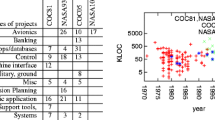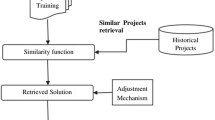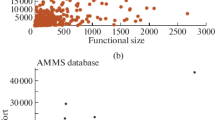Abstract
Background: Conclusion Instability in software effort estimation (SEE) refers to the inconsistent results produced by a diversity of predictors using different datasets. This is largely due to the “ranking instability” problem, which is highly related to the evaluation criteria and the subset of the data being used.
Aim: To determine stable rankings of different predictors.
Method: 90 predictors are used with 20 datasets and evaluated using 7 performance measures, whose results are subject to Wilcoxon rank test (95 %). These results are called the “aggregate results”. The aggregate results are challenged by a sanity check, which focuses on a single error measure (MRE) and uses a newly developed evaluation algorithm called CLUSTER. These results are called the “specific results.”
Results: Aggregate results show that: (1) It is now possible to draw stable conclusions about the relative performance of SEE predictors; (2) Regression trees or analogy-based methods are the best performers. The aggregate results are also confirmed by the specific results of the sanity check.
Conclusion: This study offers means to address the conclusion instability issue in SEE, which is an important finding for empirical software engineering.













Similar content being viewed by others
Notes
References
Albrecht, A., Gaffney, J.: Software function, source lines of code and development effort prediction: a software science validation. IEEE Trans. Softw. Eng. 9, 639–648 (1983)
Alpaydin, E.: Introduction to Machine Learning. MIT Press, Cambridge (2004)
Auer, M., Trendowicz, A., Graser, B., Haunschmid, E., Biffl, S.: Optimal project feature weights in analogy-based cost estimation: improvement and limitations. IEEE Trans. Softw. Eng. 32, 83–92 (2006)
Baker, D.: A hybrid approach to expert and model-based effort estimation. Master’s thesis, Lane Department of Computer Science and Electrical Engineering, West Virginia University (2007). Available from https://eidr.wvu.edu/etd/documentdata.eTD?documentid=5443
Bakir, A., Turhan, B., Bener, A.B.: A new perspective on data homogeneity in software cost estimation: a study in the embedded systems domain. Softw. Qual. Control 18, 57–80 (2010)
Boehm, B.W.: Software Engineering Economics. Prentice Hall PTR, Upper Saddle River (1981)
Brady, A., Menzies, T.: Case-based reasoning vs parametric models for software quality optimization. In: International Conference on Predictive Models in Software Engineering PROMISE’10, Sept. IEEE, New York (2010)
Breiman, L.: Technical note: some properties of splitting criteria. Mach. Learn. 24(41–47), 10 (1996) doi:1023/A:1018094028462
Breiman, L., Friedman, J., Olshen, R., Stone, C.: Classification and Regression Trees. Wadsworth and Brooks, Monterey (1984)
Chang, C.-L.: Finding prototypes for nearest neighbor classifiers. IEEE Trans. Comput. C-23(11), 1179–1184 (1974)
Fayyad, U.M., Irani, I.H.: Multi-interval discretization of continuous-valued attributes for classification learning. In: Proceedings of the International Joint Conference on Uncertainty in AI, pp. 1022–1027 (1993)
Foss, T., Stensrud, E., Kitchenham, B., Myrtveit, I.: A simulation study of the model evaluation criterion mmre. IEEE Trans. Softw. Eng. 29(11), 985–995 (2003)
Gama, J., Pinto, C.: Discretization from data streams: applications to histograms and data mining. In: SAC ’06: Proceedings of the 2006 ACM Symposium on Applied Computing, pp. 662–667. ACM Press, New York (2006). Available from http://www.liacc.up.pt/~jgama/IWKDDS/Papers/p6.pdf
Hall, M., Holmes, G.: Benchmarking attribute selection techniques for discrete class data mining. IEEE Trans. Knowl. Data Eng. 15(6), 1437–1447 (2003)
Jørgensen, M.: A review of studies on expert estimation of software development effort. J. Syst. Softw. 70(1–2), 37–60 (2004)
Jorgensen, M.: Practical guidelines for expert-judgment-based software effort estimation. IEEE Softw. 22(3), 57–63 (2005)
Kadoda, G., Cartwright, M., Shepperd, M.: On configuring a case-based reasoning software project prediction system. In: UK CBR Workshop, Cambridge, UK, pp. 1–10 (2000)
Kemerer, C.: An empirical validation of software cost estimation models. Commun. ACM 30(5), 416–429 (1987)
Keung, J.: Empirical evaluation of analogy-x for software cost estimation. In: ESEM ’08: Proceedings of the Second International Symposium on Empirical Software Engineering and Measurement, pp. 294–296. ACM, New York (2008)
Keung, J., Kitchenham, B.: Experiments with analogy-x for software cost estimation. In: ASWEC ’08: Proceedings of the 19th Australian Conference on Software Engineering, pp. 229–238. IEEE Computer Society, Washington (2008)
Keung, J.W., Kitchenham, B.A., Jeffery, D.R.: Analogy-x: providing statistical inference to analogy-based software cost estimation. IEEE Trans. Softw. Eng. 34(4), 471–484 (2008)
Kirsopp, C., Shepperd, M., Premrag, R.: Case and feature subset selection in case-based software project effort prediction. In: Research and Development in Intelligent Systems XIX: Proceedings of ES2002, the Twenty-Second SGAI International Conference on Knowledge Based Systems and Applied Artificial Intelligence, p. 61 (2003)
Kirsopp, C., Shepperd, M.J.: Making inferences with small numbers of training sets. IEEE Softw. 149(5), 123–130 (2002)
Kitchenham, B., Känsälä, K.: Inter-item correlations among function points. In: ICSE’93:Proceedings of the 15th International Conference on Software Engineering, ICSE ’93, pp. 477–480. IEEE Computer Society Press, Los Alamitos (1993)
Kitchenham, B., Mendes, E., Travassos, G.H.: Cross versus within-company cost estimation studies: a systematic review. IEEE Trans. Softw. Eng. 33(5), 316–329 (2007)
Kliijnen, J.: Sensitivity analysis and related analyses: a survey of statistical techniques. J. Stat. Comput. Simul. 57(1–4), 111–142 (1997)
Li, J., Ruhe, G.: A comparative study of attribute weighting heuristics for effort estimation by analogy. In: Proceedings of the 2006 ACM/IEEE International Symposium on Empirical Software Engineering, p. 74 (2006)
Li, J., Ruhe, G.: Decision support analysis for software effort estimation by analogy. In: International Conference on Predictive Models in Software Engineering PROMISE’07, May (2007)
Li, Y., Xie, M., Goh, T.: A study of project selection and feature weighting for analogy based software cost estimation. J. Syst. Softw. 82, 241–252 (2009)
Lipowezky, U.: Selection of the optimal prototype subset for 1-nn classification. Pattern Recognit. Lett. 19, 907–918 (1998)
Maxwell, K.D.: Applied Statistics for Software Managers. Prentice Hall, PTR, Upper Saddle River (2002)
Mendes, E., Watson, I.D., Triggs, C., Mosley, N., Counsell, S.: A comparative study of cost estimation models for web hypermedia applications. Empir. Softw. Eng. 8(2), 163–196 (2003)
Menzies, T., Jalali, O., Hihn, J., Baker, D., Lum, K.: Stable rankings for different effort models. Autom. Softw. Eng. 17, 409–437 (2010)
Milicic, D., Wohlin, C.: Distribution patterns of effort estimations. In: EUROMICRO, pp. 422–429 (2004)
Miyazaki, Y., Terakado, M., Ozaki, K., Nozaki, H.: Robust regression for developing software estimation models. J. Syst. Softw. 27(1), 3–16 (1994)
Myrtveit, I., Stensrud, E., Shepperd, M.: Reliability and validity in comparative studies of software prediction models. IEEE Trans. Softw. Eng. 31, 380–391 (2005)
Robson, C.: Real World Research: A Resource for Social Scientists and Practitioner-Researchers. Blackwell Publisher Ltd, Oxford (2002)
Shepperd, M., Kadoda, G.: Comparing software prediction techniques using simulation. IEEE Trans. Softw. Eng. 27(11), 1014–1022 (2001)
Shepperd, M., Schofield, C.: Estimating software project effort using analogies. IEEE Trans. Softw. Eng. 23(11), 736–743 (1997)
Shepperd, M., Schofield, C., Kitchenham, B.: Effort estimation using analogy. In: Proceedings of the 18th International Conference on Software Engineering, pp. 170–178 (1996)
Walkerden, F., Jeffery, R.: An empirical study of analogy-based software effort estimation. Empir. Softw. Eng. 4(2), 135–158 (1999)
Yang, Y., Webb, G.I.: A comparative study of discretization methods for naive-Bayes classifiers. In: Proceedings of PKAW 2002: The 2002 Pacific Rim Knowledge Acquisition Workshop, pp. 159–173 (2002)
Acknowledgements
This research has been funded by the Qatar/West Virginia University research grant NPRP 09-12-5-2-470.
Author information
Authors and Affiliations
Corresponding author
Appendix: Data Used in This Study
Appendix: Data Used in This Study
All the data used in this study is available either at http://promisedata.org/data or through the authors. As shown in Fig. 1, we use a variety of different data sets in this research. The standard COCOMO data sets (cocomo*, nasa*), which are collected with the COCOMO approach (Boehm 1981). The desharnais data set, which contains software projects from Canada. It is collected with function points approach. SDR, which contains data from projects of various software companies in Turkey. SDR is collected by Softlab, the Bogazici University Software Engineering Research Laboratory (Bakir et al. 2010). albrecht data set consists of projects completed in IBM in the 1970’s and details are given in Albrecht and Gaffney (1983). finnish data set originally contains 40 projects from different companies and data were collected by a single person. The two projects with missing values are omitted here, hence we use 38 instances. More details can be found in Kitchenham and Känsälä (1993). kemerer is a relatively small dataset with 15 instances, whose details can be found in Kemerer (1987). maxwell data set comes from finance domain and is composed of Finnish banking software projects. Details of this dataset are given in Maxwell (2002). miyazaki data set contains projects developed in COBOL. For details see Miyazaki et al. (1994). telecom contains projects which are enhancements to a U.K. telecommunication product and details are provided in Shepperd and Schofield (1997). china dataset includes various software projects from multiple companies developed in China.
Rights and permissions
About this article
Cite this article
Keung, J., Kocaguneli, E. & Menzies, T. Finding conclusion stability for selecting the best effort predictor in software effort estimation. Autom Softw Eng 20, 543–567 (2013). https://doi.org/10.1007/s10515-012-0108-5
Received:
Accepted:
Published:
Issue Date:
DOI: https://doi.org/10.1007/s10515-012-0108-5




